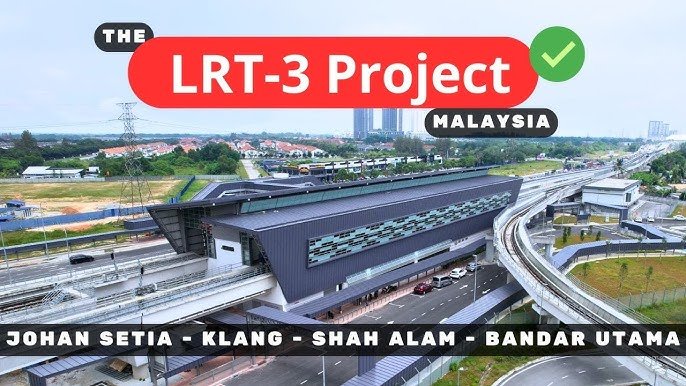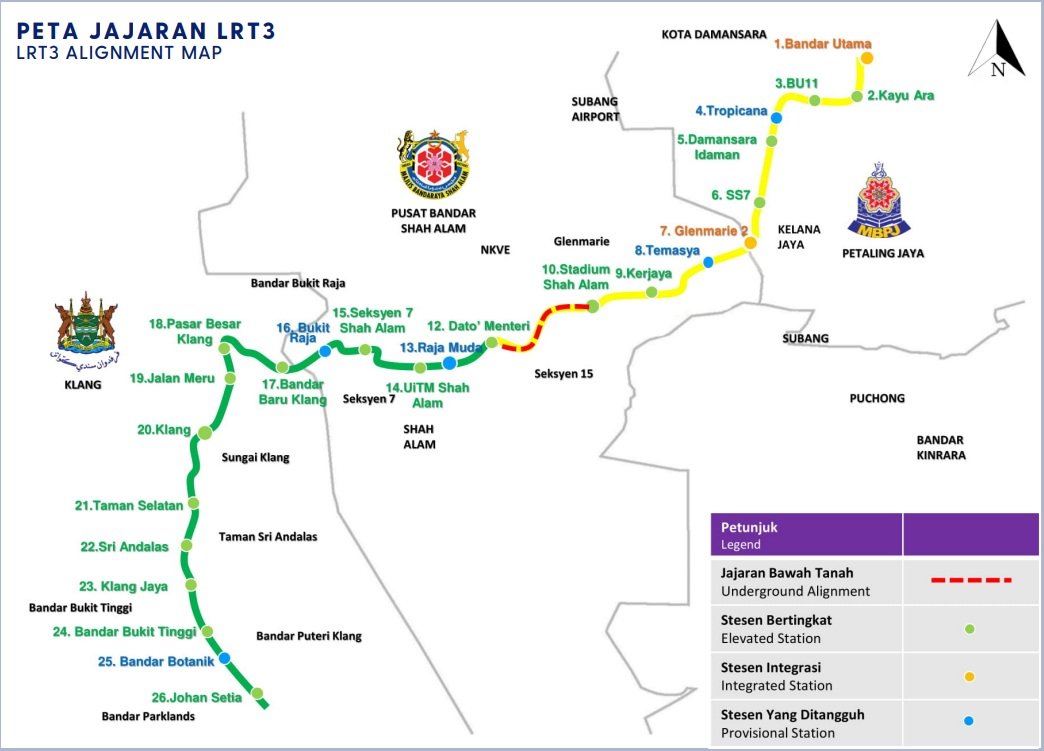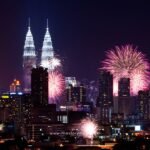

The LRT3 is a crucial addition to Malaysia’s public transport network, aimed at serving the western corridor of the Klang Valley. It will link key residential and commercial areas, reducing travel times and easing traffic congestion.
Table of Contents
ToggleLRT 3 Construction and Features
Construction started in 2017, faced delays due to the COVID-19 pandemic, but is now over 95% complete. The line will feature modern trains capable of speeds up to 80 km/h, with a capacity for 18,630 passengers per hour.
Impact and Expectations from LRT 3 Line
Once operational, the LRT3 is expected to boost local economies, lower carbon emissions, and improve quality of life, with projections of serving tens of thousands of passengers daily.
Survey Note: Detailed Analysis of LRT3 Line Operations Starting September 30, 2025

Kuala Lumpur: The Light Rail Transit Line 3 (LRT3), also known as the Shah Alam Line, is set to begin operations on September 30, 2025, according to an announcement by the Ministry of Transport on February 27, 2025. This development marks a significant milestone in Malaysia’s efforts to enhance public transportation in the Klang Valley, particularly in the western corridor. This detailed survey note explores the background, construction progress, features, impact, and future plans of the LRT3, providing a comprehensive overview for readers interested in urban transport developments.
Background and Significance of LRT3
The LRT3 is a vital component of Malaysia’s public transport masterplan, designed to serve the western corridor of the Klang Valley. Spanning 37.6 kilometers, the line will connect Bandar Utama in Petaling Jaya to Johan Setia in Klang, linking key residential and commercial areas. This connection is expected to reduce travel times, ease traffic congestion, and provide a reliable alternative to private vehicles. The project, costing MYR16.63 billion, is being developed by Prasarana Malaysia Berhad, a key player in transforming Malaysia’s urban rail services.
The idea for the LRT3 was first proposed in 2016 as part of the Land Public Transport Masterplan. After several years of planning and procurement, construction began in 2017, aiming to integrate with existing rail networks like the MRT Sg. Buloh – Kajang Line at Bandar Utama and the LRT Kelana Jaya Line at CGC Glenmarie. This integration is part of the Greater Klang Valley’s Land Public Transport Masterplan, aimed at creating a seamless and efficient transport system.
Construction Progress and Challenges
Construction of the LRT3 started in 2017 but faced significant challenges, including delays due to the COVID-19 pandemic. Despite these setbacks, the project has made substantial progress, with physical works reaching 95% completion as of July 2024, according to updates from Transport Minister Anthony Loke. The remaining tasks involve the installation and testing of key systems such as signalling and train operations, ensuring safety and efficiency before the launch.
The project initially had a scheduled completion date of 2024, but delays pushed it to 2025. Minister Loke attributed the delay to a slowdown during the pandemic period, noting that Prasarana and the contractors have worked hard to claw back time and reduce the delay. Recent updates indicate that by October 2024, all physical work, including large interchange stations, would have been completed, with system integration and testing expected to take three to four months.
Features of the LRT3 Line
The LRT3 will feature 22 three-car trains, each capable of speeds up to 80 km/h. These trains are designed with passenger comfort in mind, featuring air conditioning, CCTV surveillance, and real-time information displays. Each train will have a capacity of approximately 300 passengers, contributing to a line capacity of 18,630 passengers per hour. This capacity is significant, given the expected demand in the densely populated western corridor.
The line will include 20 stations, strategically located to serve various residential and commercial areas. Key stations include Bandar Utama, an interchange with the MRT Kajang Line, and CGC Glenmarie, an interchange with the LRT Kelana Jaya Line. Other stations, such as Taman Bahagia, Taman Intan Baiduri, and Johan Setia, will cater to local communities, ensuring comprehensive coverage. The journey from Bandar Utama to Johan Setia is expected to take approximately one hour, offering a convenient and efficient travel option for commuters.
The LRT3 will use a contactless smart card system for ticketing, compatible with existing public transport fare systems in the Klang Valley. This integration will allow passengers to use a single card for multiple modes of transport, enhancing convenience and encouraging public transport usage.
Impact and Expectations
Once operational, the LRT3 is anticipated to have a profound impact on the local economy and quality of life. By providing a direct link between key areas, it will reduce traffic congestion, lower carbon emissions, and stimulate property development around its stations. Local businesses are already preparing for increased foot traffic and improved accessibility, with projections suggesting the line could serve tens of thousands of passengers daily, with potential to grow as the area develops.
Local residents and business owners are eagerly anticipating the launch. Mr. Lim, a resident of Taman Sri Muda, expressed his excitement, saying, “I’ve been waiting for this for years. It will make my commute to work in Bandar Utama so much easier and faster. No more sitting in traffic jams!” Ms. Tan, who runs a café near one of the stations, added, “Having the LRT station nearby will definitely bring more customers. It’s great for my business and the community as a whole.”
The environmental benefits are also significant. By encouraging more people to use public transport, the LRT3 will help reduce the number of private vehicles on the road, leading to lower air pollution and a smaller carbon footprint for the region. This aligns with Malaysia’s commitment to sustainable development and urban planning.
Quotes from Officials and Community Perspectives
Transport Minister Anthony Loke expressed his confidence in the project’s progress, stating, “The LRT3 is a critical component of our public transport masterplan. Its completion will not only benefit current residents but also support future growth in the region. We are working diligently to ensure that all systems are thoroughly tested and ready for safe and efficient operations by September 30.”
During a recent site visit to the Johan Setia Depot, Minister Loke noted, “I have seen the significant advancements in construction and the rigorous testing of the trains. Everything is on track for a safe and successful launch on September 30.” These statements reflect the government’s commitment to delivering a reliable and efficient public transport system.
Community perspectives highlight the anticipation and expectations. Local resident Mr. Lim’s comment underscores the personal benefits, while Ms. Tan’s remark illustrates the economic opportunities. These voices add a human element, showing how the LRT3 will impact daily lives and local economies.
Future Plans and Integration
Looking ahead, there are plans to expand the LRT3 network to include additional stations, further enhancing its coverage and connectivity. The Ministry of Transport is also exploring integration with other public transport modes, such as buses and future rail lines, to create a seamless travel experience for users. This integration is part of a broader vision to develop a comprehensive and efficient transport system in the Klang Valley, supporting Malaysia’s urban growth and sustainability goals.
The LRT3’s launch on September 30, 2025, is a testament to the nation’s commitment to improving quality of life through efficient public transport. As Malaysia continues to urbanize, projects like the LRT3 will play a crucial role in transforming how people move and connect, fostering economic growth and environmental sustainability.
Detailed Breakdown of Benefits
To provide a clearer picture, here is a table summarizing the key benefits of the LRT3:
| Benefit | Details |
|---|---|
| Enhanced Connectivity | Connects Bandar Utama to Johan Setia, linking key residential and commercial areas. |
| Reduced Travel Time | Expected journey time of approximately one hour, reducing reliance on private vehicles. |
| Increased Capacity | Capable of handling 18,630 passengers per hour, easing public transport demand. |
| Economic Growth | Expected to boost property values and attract investments around stations. |
| Environmental Impact | Reduces carbon emissions by encouraging public transport use, lowering air pollution. |
| Community Integration | Serves local areas like Taman Bahagia and Taman Sri Muda, enhancing accessibility. |
This table highlights the multifaceted benefits, from economic to environmental, that the LRT3 will bring to the Klang Valley.
Conclusion by The Story Mojo
The LRT3’s commencement on September 30, 2025, marks a significant step forward for Malaysia’s public transport system. With its extensive coverage, modern features, and anticipated impact, the line is poised to transform commuting in the western corridor of the Klang Valley. As the project nears completion, it stands as a beacon of sustainable urban development, promising improved connectivity, economic growth, and a better quality of life for residents.
©2025 thestorymojo.com All rights reserved.






Be the first to leave a comment